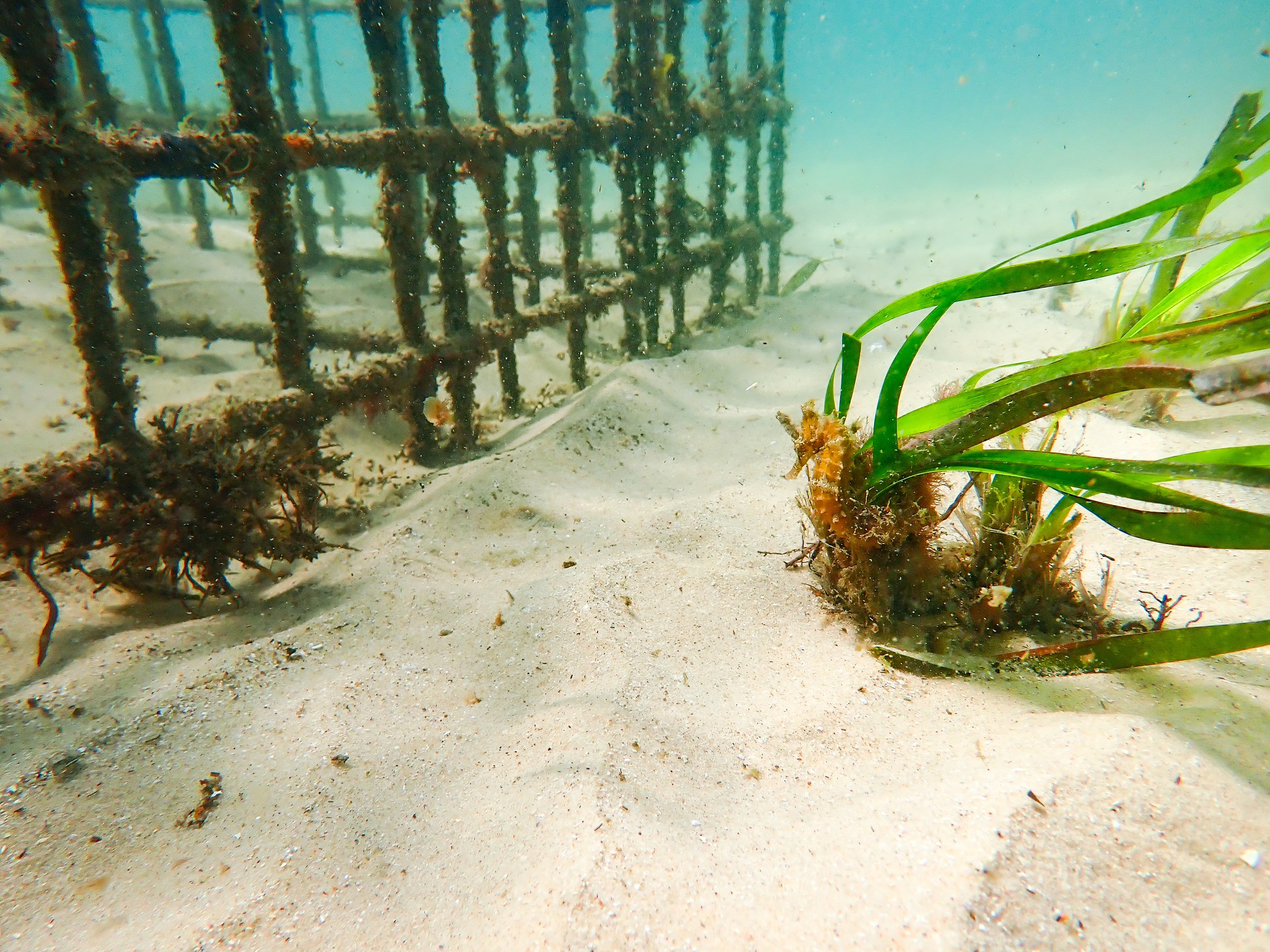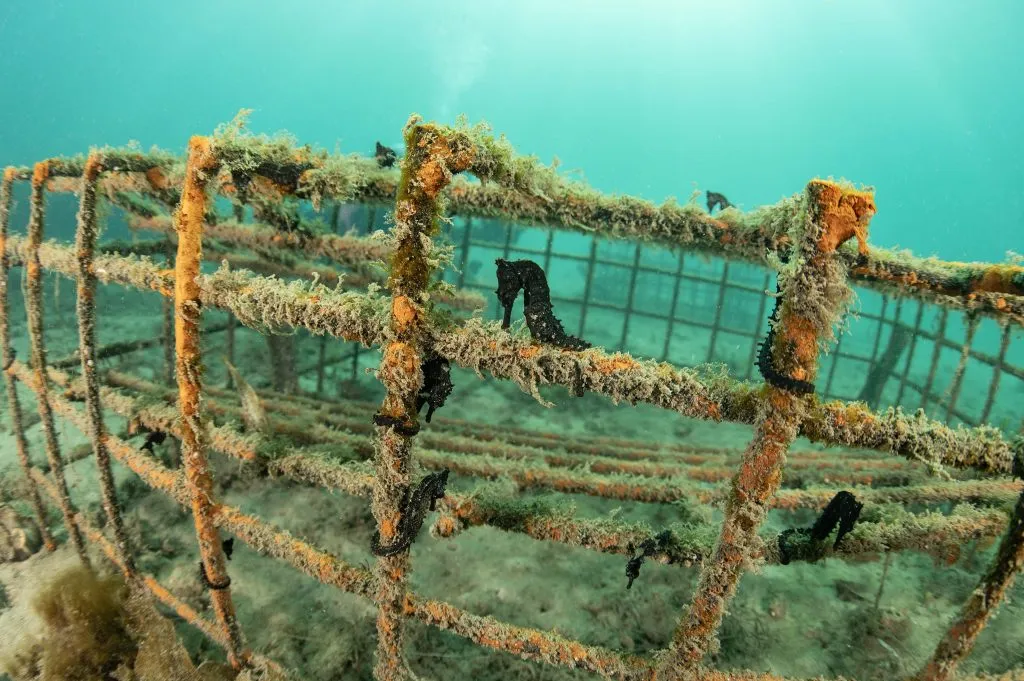
Greener Pastures
Co-restoration of an endangered endemic seahorse and its habitat
The White’s Seahorse (Hippocampus whitei) is endemic to the east coast of Australia. These unique animals rely on habitats such as Posidonia meadows, sponge gardens and kelp. In 2015, Posidonia australis meadows in the Hawkesbury-Manning Bioregion were listed as an endangered ecological community under the EPBC act. With the increasing loss of their natural habitat, White’s seahorse populations have also been declining.
The White’s Seahorse is now listed as Endangered under the NSW Fisheries Management Act and the IUCN Red List of Threatened Species.
Artifical Habitat
Natural Habitat
Increasingly, White’s Seahorses are using artificial habitats such as swimming nets, discarded fish traps and other debris. The Greener Pastures project tackles habitat loss by installing artificial structures called “Seahorse Hotels” and working collaboratively to restore critical habitats, including the endangered seagrass Posidonia australis.
Additionally, the project collaborates with the Sydney Seahorse Project to boost wild seahorse populations through a conservation stocking program, where seahorses are bred and raised in captivity at the Sydney Institute of Marine Science (SIMS) before being released into their natural environment.

Come visit the ‘Seahorse Hotels’
The ‘Seahorse Hotels’ are a creative conservation method being used to assist the recovery of White’s Seahorse populations. The Hotels are purpose-designed artificial habitat units that are made out of biodegradable materials and metal, which rusts away in the seawater. These structures mimic discarded fish traps, which we know the seahorses use as a makeshift home. Over time, the hotels become covered in marine organisms like sponges, soft corals and seaweed, which provide shelter and food to the seahorses.
Seahorse Hotels are populated with captive-bred seahorses from the Sydney Seahorse breeding project at SEA Life Sydney Aquarium and SIMS, boosting local populations.
Photos courtesy of John Turnbull.
In the “Greener Pastures” project, we are combining the use of Seahorse Hotels with restoration of Posidonia, giving seahorses the best chance while we work on the recovery of their natural habitats.
The preferred habitat of the White’s Seahorse is Posidonia australis. The Greener Pastures project uses the Operation Posidonia restoration techniques to support two threatened species: White’s Seahorse and its habitat, Posidonia australis meadows. Local communities will help collect storm-dislodged shoots for replanting. Juvenile seahorses are released onto “seahorse hotels” in restored areas, providing shelter as their natural habitat recovers.
Meet the Team
-

Prof Adriana Verges
Adriana is a marine ecologist based at UNSW Australia and the Sydney Institute of Marine Science. She hails from the Mediterranean, where she grew up surrounded by lush meadows of Posidonia oceanica, the only Posidonia species found outside of Australia. She’s one of the lead investigators of sister-project Operation Crayweed, which is restoring another important species, crayweed, in Sydney reefs.
-

Prof David Booth
David Booth a Professor of Marine Ecology in the School of Life Sciences at UTS, David has published more than 180 papers about reef-fish ecology, climate change and other anthropogenic impacts on fishes and fisheries, in the Caribbean, Hawaii, and the Great Barrier Reef. He has spent nearly two decades monitoring the migration of tropical fish down the East Australian Current, past Sydney.
-

Dr David Harasti
David Harasti is a Senior Research Scientist based at the Port Stephens Fisheries Institute. He is a marine biologist with over 20 years experience working on threatened marine species and marine biodiversity. David previously worked in threatened species management, focusing on recovery plans for species such as grey nurse, great white sharks and black cod, before commencing research on evaluation of Marine Protected Areas in 2008.
-

Mitchell Brennan
Mitchell is currently undertaking a PhD focused on developing the conservation methodologies for the Endangered White's Seahorse, Hippocampus whitei, including assessing the efficacy of conservation translocation programs and habitat provision
-

Jack Vitnell
Jack's background in marine project management makes him well-suited for his role as Project Coordinator. With significant experience at both Manly and Sydney Sea Life aquariums, overseeing operations at Seabin, and exploring the startup sector, Jack brings a diverse skill set to the Operation Posidonia team.
-

Laura Simmons
Laura Simmons is the Displays Curator at SEA LIFE Sydney Aquarium where she ensures the highest standards of care and welfare of all animals in the aquarium as well as support and spearhead conservation initiatives. Laura is a self-proclaimed “aquarium nerd” with 30 years experience in the global aquarium industry.
Operation Posidonia acknowledges the Traditional Custodians of the Country on which we conduct our research. We recognise their continuing connection to the land and waters, and thank them for protecting the coastline and its ecosystems for many generations. We extend these respects to Elders past and present, and to all First Nations people.






